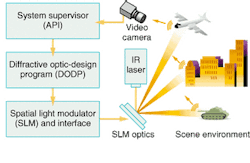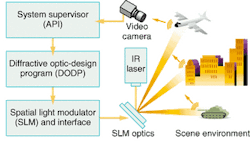Diffractive SLM steers multiple beams
University, commercial, and government researchers are contributing to the design, development, and construction of an intelligent, adaptive, multiple-spot beam-steering system based on diffractive optics. The heart of the project consists of a liquid-crystal-on-silicon spatial light modulator (SLM) used as a programmable real-time diffractive optical element, rather than for image display. Potential applications range from multiple-target laser designation and tracking systems for military use to multiple-trapping laser tweezers for biomedical or nanofabrication tasks (see figure).
"One could imagine projecting a liquid crystal as an imaging display and you would just get the light from individual pixels," said Robert Cohn, who is leading the research effort from the University of Louisville (Louisville, KY). "However, if you use it as a diffractive or fourier-transform device, you could come up with something that was a linear superposition of lenses, or a linear superposition of tilted mirrors. So then you could have a much more efficient use of the light."
null
Cohn demonstrates this capability with a live optical cartoon he calls the "running man," which is a running stick figure consisting of about 60 spots, all controlled from the same SLM, as opposed to having a linear superposition of 60 mirrors tilted at 60 different angles. "Diffractive optics gives you much more flexibility," he said.
The SLM design consists of an array of pixels in which each pixel is a phase shifter. "It's a phase-only phased-array antenna," Cohn said. "And a lot of the design issues have to do with designing the diffraction pattern you want with only phase control but no amplitude control."1
Phase-only modulation with coherent light is a key ingredient of the optical processing function that will be needed for the intended beam-steering application (see Laser Focus World, May 1999, p. 229). "If you are modulating phase and you also change amplitude, you lose a lot of optical throughput in the amplitude," said Marty Best, president and chief executive officer of Boulder Nonlinear Systems (Boulder, CO), one of several collaborators in the intelligent-vision-system project.
The proposed nonmechanical beam-steering system will produce multiple spots in a range of patterns. The patterns could be used to provide selective illumination for designating objects, highlighting them, or perhaps just selectively illuminating an area, Cohn said. If the team is successful in producing a working prototype, the concept should provide a basis for some very intelligent image sensors.
They have already demonstrated that the algorithms for the proposed vision system work. The task now is to prove that they work in a real system. "It's a big step from simply saying, 'Here's a single light modulator and it can do all of these wonderful things,' to actually building it into a system that is adaptive in the sense that we are going to put it under a microscope to track particles that will be bouncing around due to Brownian motion. You need a pretty smart tracking system for that," Cohn said.
The project entered phase II of a DARPA-funded Small Business Technology Transfer program in August. Collaborators in addition to the University of Louisville and Boulder Nonlinear Systems, which fabricates the SLM, include the University of Kentucky (Lexington, KY), which is developing a higher-level control system to coordinate tracking functions; laser-tweezers manufacturer Cell Robotics International (Albuquerque, NM); and Mission Research (Los Angeles, CA), which is providing assistance with algorithms based on experience using the SLM. Wright-Patterson Air Force Base (Ohio) has also offered to allow the researchers to demonstrate the complete device alongside an existing single-spot beam-steering system.
REFERENCE
- L. Ge, M. Duelli, R. W. Cohn, Optics Express 7(12) (December 2000).

